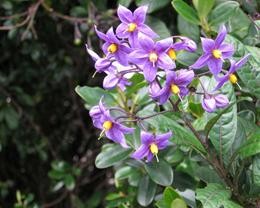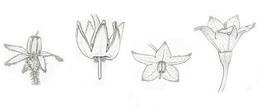Linneaus if You Do Not Know Name You Do Not Know Plant
Test instance for electronic publication of new species names breaks with over 200 years of history.

Solanum sanchez-vegae and 3 other new plant species take had their names published exclusively online. Credit: Southward. Knapp
Botany may finally be entering the electronic historic period, as four plants become a examination case for naming species in purely electronic journals.
Their clarification in an online-just journal highlights the issues facing biologists equally they effort to reform the conventions that govern the naming of species, balancing issues including peer review, archiving and electronic publication. Paper publication has been the gold standard since Carl Linnaeus gave birth to mod taxonomy in the eighteenth century.
Rules set out past the International Code of Botanical Nomenclature (ICBN) insist that new species be officially declared by the "distribution of printed matter" and non "solely by distribution electronically".
However, Sandra Knapp of London's Natural History Museum believes she has come with a fashion effectually this rule. Her latest paper, published in the online-only, open-access journal PLoS One, describes four newly discovered plants1.
There is nothing very unusual virtually the plants themselves, which all belong to the Solanum genus — one of the largest genera of flowering plants. But it is the first time new plant names have been published in a purely electronic periodical and yet complied with ICBN rules. So the publication serves equally a test case for changes being developed for the code.
The newspaper represents the culmination of a entrada to institute the electronic publication of scientific names, a case Knapp and others accept made in journals including Nature 2. Assuasive electronic publication should brand accessing information easier for scientists worldwide — especially those in developing countries who may non accept access to fully stocked libraries. This, in turn, will aid conservation efforts, Knapp says.
"It allows people to know there's something to wait for," she told Nature. "The only reason to proper noun something is to let people to study it further. Past assuasive electronic publication, this can get easier for people to get at."
Post the print-outs
To become around the ICBN (come across Box 1), Knapp will print out copies of the article and post them to 10 libraries — including the International Institute Names Index, which is maintained by a partnership of the Royal Botanic Gardens in London, the Harvard Academy Herbaria in Massachusetts and the Australian National Herbarium in Canberra — to fulfil the stipulation of Article 29.

Box one | Click on the image for a larger version of Article 29, Department one, of the International Lawmaking of Botanical Classification.
Click here for larger image
This should ensure that her descriptions of Solanum aspersum, Solanum luculentum, Solanum sanchez-vegae and Solanum sousae — all from Central and Southward America — are accustomed. In addition, the Public Library of Sciences (PloS), publishers of PLoS I, has produced guidelines for authors who wish to follow Knapp's example.
"As online publications are an increasingly of import part of scientific publication, it would be undesirable if online publications were totally excluded from publishing taxonomic novelties," says John McNeill, a researcher at the Royal Botanic Garden in Edinburgh, Britain, and primary rapporteur for the Nomenclature Department of the International Botanical Congress. "On the other paw, the establish taxonomic customs is, justifiably I believe, still very concerned regarding the permanence and, peradventure even more, the immutability of electronic publications."
McNeill, who advised Knapp on her paper, adds, "A mechanism such as that outlined in the PLoS guidelines would seem a good compromise under the electric current rules."
Modify the codes
In the longer term, Knapp and others promise that the naming code itself can be revised. The next opportunity for this to happen volition be at the 2011 International Botanical Congress in Melbourne, Australia, where Knapp will preside over the classification committee.
A like debate is raging in the globe of zoological nomenclature. The International Commission on Zoological Nomenclature, which revises its rules differently from the botanical world, is currently because proposed amendments that would allow electronic publication of new species names3.
And there are other, related issues. At present, in that location is no stipulation that publications must be peer reviewed for official naming. Although Knapp says she does not call back it realistic to wait all naming publications to exist peer reviewed, there may be a strong case for all online-but publications to exist peer reviewed before new names are accepted.

Sketches of the flowers of the four new species: (from left to correct) Solanum aspersum, S. luculentum, S. sanchez-vegae and S. sousae. Credit: S. Knapp
Werner Greuter, chairman of a previous iteration of the ICBN, is wary of requiring peer review, although he agrees that the rules need reforming. "It's much too easy to publish things without people existence aware of them," he says. He adds that Knapp's new method is not revolutionary equally "in this case electronic publication is but a squeamish extra. What counts are the paper copies."
Just libraries are cutting dorsum on buying print copies of journals and it is not clear whether naming papers that are published solely online will exist available in future unless impress copies are widely circulated besides.
"We know about newspaper lasting for a couple of millennia at least. We don't know about our electronic systems — endeavour reading an 8 inch floppy deejay now," says Greuter. "Is it really so bad to accept a newspaper copy stored in a number of places?"

References
Related links
Rights and permissions
Near this commodity
Cite this article
Cressey, D. Linnaeus meets the Internet. Nature (2010). https://doi.org/10.1038/news.2010.221
-
Published:
-
DOI : https://doi.org/ten.1038/news.2010.221
connorscattesidn88.blogspot.com
Source: https://www.nature.com/articles/news.2010.221
0 Response to "Linneaus if You Do Not Know Name You Do Not Know Plant"
Post a Comment